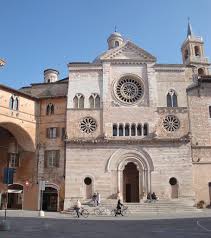Il Duomo di Foligno è situato nel pieno centro di Foligno, in Piazza della Repubblica, ed è il massimo monumento artistico cittadino. L’edificio è noto come Cattedrale di San Feliciano, poiché sorge proprio nel luogo in cui il santo e patrono della città venne martirizzato e sepolto nel 251 d.C.
![]()
Cattedrale di San Feliciano, Foligno
La cattedrale presenta un’interessante sovrapposizione di stili ed epoche successive: eretta sul sito di un edificio sacro risalente al IX-X secolo, venne rinnovata nel 1133. Subì una prima aggiunta nel 1201 (il transetto sinistro) e degli ingrandimenti tra il 1457 e il 1465 (coro ed abside). Seguirono poi delle trasformazioni importanti:
- la prima portò alla demolizione delle navate laterali e diede all’edificio l’attuale forma a croce latina con navata unica e volte a crociera, il tutto sotto la supervisione di Cola Da Caprarola
- tra il 1543 e il 1548 venne aggiunta la cupola, su disegno di Giuliano di Baccio D’Agnolo
- la seconda radicale trasformazione avvenne a cavallo tra ‘700 e ‘800, con un intervento in stile neoclassico progettato da Giuseppe Piermarini
- nel 1904 vennero restaurate le facciate esterne, ripristinando le originarie forme romaniche
- già restaurata dopo il terremoto del 1997, è attualmente in attesa di nuovi interventi di ripristino e messa in sicurezza [IN ATTESA DI AGGIORNAMENTI SULLA RIAPERTURA]
![]()
L’esterno della Basilica è ben riconoscibile per le caratteristiche fasce bianche e rosa. La facciata presenta archi multipli e una loggetta affiancata da bifore, oltre al mosaico raffigurante “Cristo in trono tra San Feliciano e Messalina”, protettori della città e raffigurati assieme a papa Leone XIII committente del lavoro.
La facciata secondaria si apre sul lato più grande di Piazza della Repubblica e vi troviamo una grande ricchezza di elementi decorativi e di simboli evangelici. La facciata è meglio conservata e si caratterizza anche per il portale romanico, decorata con bassorilievi.
All’interno dell’antica chiesa romana rimane solamente la cripta mentre le tre navate, dopo aver subito notevoli modifiche già nel 400 e nel 500, hanno assunto in seguito al progetto di Vanvitelli e all’intervento di Giuseppe Piermarini l’aspetto attuale. Tra le opere più significative presenti nel Duomo, va evidenziata la cappella cinquecentesca del Sacramento di Antonio da Sangallo il Giovane.
![]()
The Foligno Cathedral (or Cathedral of San Feliciano), built in the Romanic style during the 12th century, is the city’s most important artistic monument; its main facade boasts multiple arches and a small loggia flanked by windows with two lights, while on the larger side which faces the Square you’ll find rich decorative elements and evangelistic symbols in abbundance.
In the inside, only the crypt remains of the ancient church, while the three naves, after having undergone extensive modifications already during the 15th and 16th centuries have assumed their present-day appearance according to the plans of Vanvitelli and the intervention of Giuseppe Piermarini. Among the most important works of art in the Cathedral we would like to point out the Chapel of the Sacrament by Antonio of Sangallo the Younger (16th century).
The Foligno Cathedral (or Cathedral of San Feliciano), built in the Romanic style during the 12th century, is the city’s most important artistic monument; its main facade boasts multiple arches and a small loggia flanked by windows with two lights, while on the larger side which faces the Square you’ll find rich decorative elements and evangelistic symbols in abbundance.
In the inside, only the crypt remains of the ancient church, while the three naves, after having undergone extensive modifications already during the 15th and 16th centuries have assumed their present-day appearance according to the plans of Vanvitelli and the intervention of Giuseppe Piermarini. Among the most important works of art in the Cathedral we would like to point out the Chapel of the Sacrament by Antonio of Sangallo the Younger (16th century).
The Foligno Cathedral (or Cathedral of San Feliciano), built in the Romanic style during the 12th century, is the city’s most important artistic monument; its main facade boasts multiple arches and a small loggia flanked by windows with two lights, while on the larger side which faces the Square you’ll find rich decorative elements and evangelistic symbols in abbundance.
In the inside, only the crypt remains of the ancient church, while the three naves, after having undergone extensive modifications already during the 15th and 16th centuries have assumed their present-day appearance according to the plans of Vanvitelli and the intervention of Giuseppe Piermarini. Among the most important works of art in the Cathedral we would like to point out the Chapel of the Sacrament by Antonio of Sangallo the Younger (16th century).
The Foligno Cathedral (or Cathedral of San Feliciano), built in the Romanic style during the 12th century, is the city’s most important artistic monument; its main facade boasts multiple arches and a small loggia flanked by windows with two lights, while on the larger side which faces the Square you’ll find rich decorative elements and evangelistic symbols in abbundance.
In the inside, only the crypt remains of the ancient church, while the three naves, after having undergone extensive modifications already during the 15th and 16th centuries have assumed their present-day appearance according to the plans of Vanvitelli and the intervention of Giuseppe Piermarini. Among the most important works of art in the Cathedral we would like to point out the Chapel of the Sacrament by Antonio of Sangallo the Younger (16th century).



Comment (0)